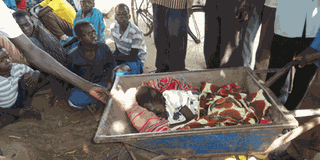Queries linger as Health ministry establishes treatment centres

A child suffering form the disease is transported in a wheelbarrow . FILE PHOTO
What you need to know:
Even though Acholi sub-region health officials say the steps taken so far by the ministry are encouraging, the pace at which action is being taken is still frustrating.
The Ministry of Health has set up centres for managing the nodding disease symptoms in Kitgum, Lamwo and Pader districts.
A 32-bed capacity ward in Kitgum Hospital has been designated for screening and offering care to thousands of children affected by the yet-to-be diagnosed ailment.
A similar effort has been made in Palabek Kal Health Centre III in Lamwo District, where a ward that will accommodate 14 patients, has been prepared.
Padibe Health Centre IV, earlier picked as one of the centres to screen and manage nodding disease symptoms, will now handle nutritional therapy in Lamwo District.
An eight-bed capacity ward will be used to treat children with severe malnutrition, resulting from nodding disease.
In Lacekocot Trading Centre, Pader District, curious residents, hundreds of whom are nursing their sick children, could be seen staring at a newly-placed signpost that reads “nodding disease services offered here”.
Even as district health officials say the steps taken so far by the ministry are encouraging, the pace at which action is being taken is still frustrating parents, some of whom have more than a child, nodding every day.
Training health workers
The ministry will for instance, beginning this week, train selected health workers to manage the cases, and with a date for launching the centres still unspecified, parents will have to wait a little more, as their sick children suffer.
Health Ministry Spokesperson Rukia Nakamantte, when asked when the launch will take place, said ‘no official date yet, but if we are to launch, it will be the other week, because this week (beginning Monday/20th) is for training”.
At Kitgum Hospital Medical Social Worker Collins Kidaga says despite the available beds, mattresses and half of the required drugs for managing nodding symptoms, gaps still needs to be filled before the facility can be ready for use.
He says certain equipment such as macintoshes for the beds, bed sheets drip stands and drugs to be delivered by National Medical Stores, are still to be provided.
A tour of the ward also reveals half finished work on the facility. Sources at the hospital say, as a result of shoddy work, the ceiling board collapsed, leaving bare wood on the ceiling and partitions standing menacingly in the ward.
A new firm is set to fix the mess, but when they will complete the work, is still unknown. The ward was constructed and equipped with beds and mattresses with funding from the American government as a pediatric ward.
The selection and training of some health workers to handle nodding disease symptoms is also raising fears of a human resource gap that will be created in health centres from which they were picked.
Mr Kidaga says the health department has raised the issue with the district to have health workers recruited, or some picked from other areas not affected by the ailment.
Although the district is counting on some NGOs for medical supplies, Mr Kidaga says the health ministry should consider special recruitment of staff to manage the symptoms, despite its temporary halt in recruitment.
However, Mr Mwaka Agoba of Padibe Health Centre IV says they will address the human resource gap by ensuring that health workers selected to care for the patients work in shifts.
The assistant HIV/Aids coordinator, also to undergo training for nodding disease care, says even though Lamwo has a staffing level of only 34 per cent and only one of the required four personnel for the nutrition therapy unit, back-up would be obtained in case the number of patients shoot up.
Meanwhile, the health centres selected to handle nodding were considered basing on their accessibility by patients in the affected areas.
Padibe Health Centre IV, although earlier chosen as one of the centres, was for instance dropped after officials realisd that Palabek Kal is more central and near to the disease-prone parishes of Anaka and Cubu.
Transport problem
Even with this consideration, parents will still have to find some means of transportation for their children since the distance to the health centres is not walkable. Palabek Kal Health Centre III, will for instance serve six parishes of Anaka, Padwat, Apyeta, Cubu, Gem, and Patanga.
Ms Christine Akumu of Amida Parish, Kitgum Distance, says provisions have to be made for bicycle ambulances to ease transportation of the sick.
“I cannot afford to transport my child to the hospital, I have been tied up at home looking after her without work,” she says, explaining the fear of leaving her daughter alone in case she gets seizure attacks and falls in water or fire.
For now, the districts are mobilising the community to register at any health centre, children presenting nodding, running saliva, stunted growth, seizures or malnutrition, because the outcome of that registration and outcome of ongoing actions will, according to Mr Agoba, ‘justify the need for more resources”.
Utility: The disease
The symptoms of nodding disease are very peculiar. When a child is affected by it, his/her growth appears to be completely and permanently stunted. The growth of the brain is also stunted, leading to mental retardation of the victim. The disease is named nodding syndrome since it causes pathological nodding. This is a seizure which often begins when the victim begins to eat food, or sometimes when he/she feels cold.[5] These seizures are brief and halt after the child stops eating or when they feel warm again. These seizures can manifest themselves with a wide degree of severity.




